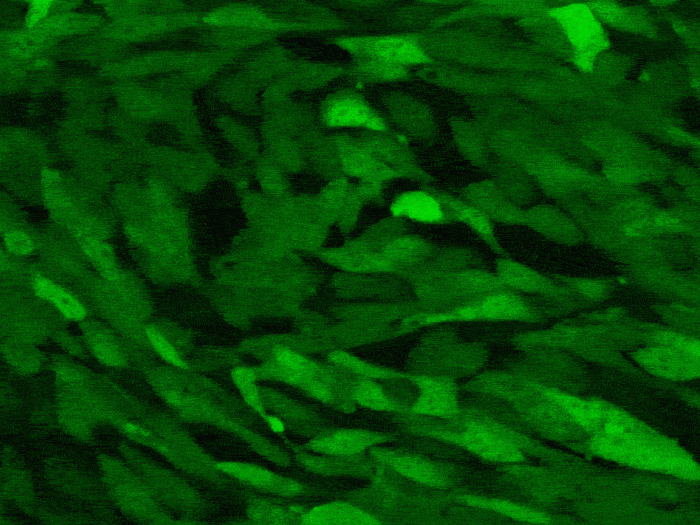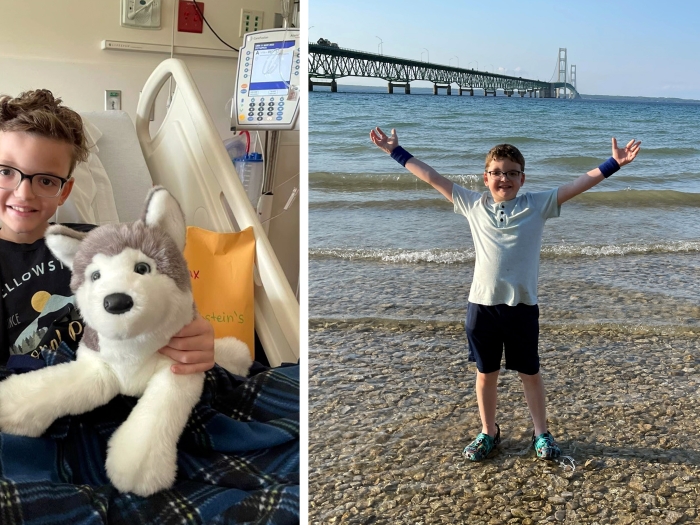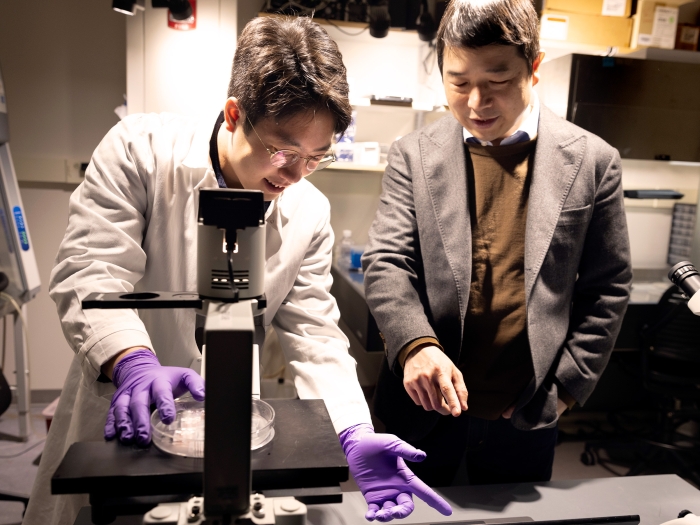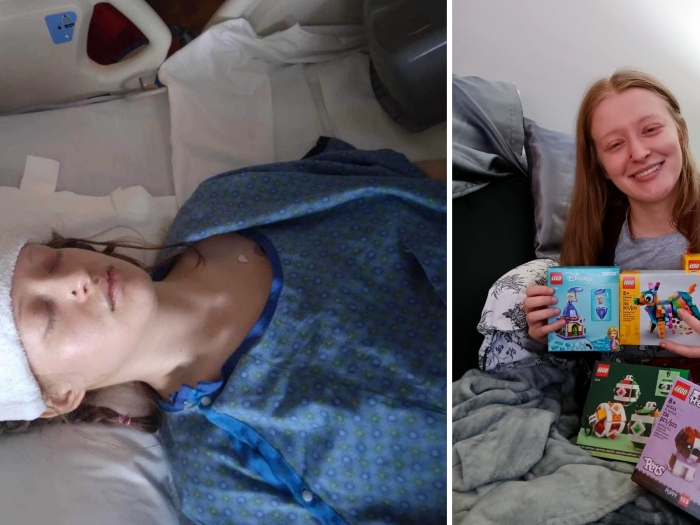5:00 AM
Author |

A Michigan woman is feeling “completely back to normal” after surviving a brain aneurysm bleed that — more often than not — kills people or leaves them with serious neurologic deficiencies.
“I felt the progression pretty much every day after a week of being home,” said Kim Streitmatter, 53. “Around Thanksgiving, the headaches mostly went away. By January, I was like, ‘This is it. I’m back.’”
Headaches were fairly common for Streitmatter, who was diagnosed with multiple sclerosis 10 years ago. But on Sept. 29, 2022, the finance manager from Midland, Mich., remembers telling some of her colleagues that she wasn’t feeling quite right and needed to go home to lie down.
SEE ALSO: Ischemic vs Hemorrhagic Stroke: The Difference Between Types of Strokes (michiganmedicine.org)
That was abnormal. It’s also the last thing she remembers of the early fall day.
“I’m really feeling dizzy, sick and I feel like I could pass out.”
“Come home. Seriously”
Kim’s husband, Matt Streitmatter, received these texts while returning to work after going out for a coffee. He called back, but she did not respond. The seven-minute drive back to their home, he recalls, felt ominous.
“When I got home, she was laying on her back between two chairs in front of the fireplace; she was unresponsive, unconscious and aspirating on her own vomit,” Matt Streitmatter said. “I started clearing her airway and called 9-1-1, and the dispatcher talked me through administering chest compressions. Before the ambulance arrived, she sat up but was unable to speak and could only stare blankly ahead.”
The diagnosis
Tests at MyMichigan Health showed bleeding around Kim Streitmatter’s brain known as hemorrhagic stroke. A CT angiogram would confirm that a weak, bulging blood vessel only around three millimeters in size had burst on the surface of her brain.
A subarachnoid hemorrhage: a ruptured brain aneurysm.
The rare condition makes up fewer than 10% of all strokes and affects around one in 15,000 people a year. Scientists have some idea about vulnerability of aneurysms — like size of the aneurysm, family history, high blood pressure and smoking — but don’t know exactly what makes one rupture. When it occurs, patients often feel a sudden “thunderclap headache”, says Neeraj Chaudhary, M.D., a neurointerventionalist at University of Michigan Health.
“Around one-third of patients will die immediately from the bleeding in and around the surface of the brain, with no mechanism to absorb the increased pressure due to the bony skull encasing the brain,” Chaudhary said. “Around one-third will survive with major neurological deficits. The remaining third may survive after a hospital stay that secures the aneurysm, but they will still have some deficit. A complete recovery is exceedingly rare.”
The Midland care team secured a transport to U-M Health, where a neurosurgical team led by David Altshuler, M.D., evaluated Streitmatter. Further testing showed that the aneurysm was small, but the bleeding had already caused her to fall unconscious and require intubation.
A friend from Matt Streitmatter’s church drove him to Ann Arbor while he called Kim’s parents and their two sons, Zach, 25, and Nathan, 21. They worked with Rebecca Pinard, a U-M Health social worker, who stayed late to ensure the whole family could see Kim that night.
Around one-third will survive with major neurological deficits. The remaining third may survive after a hospital stay that secures the aneurysm, but they will still have some deficit. A complete recovery is exceedingly rare.
“We all just prayed that she would be OK,” Matt Streitmatter said. “I’m a man of very strong faith. I was praying a lot and had hundreds of friends, co-workers, family and people from our church and bible study groups back home praying with us. A former boss offered up her Ann Arbor home to my family during the two weeks while Kim was in the hospital. This is not something you ever think about or plan for, so it was a huge blessing to not have to worry about where we were going to stay.”
A minimally invasive treatment
Once the multidisciplinary team of neurosurgeons and neurointerventionalists analyzed Kim Streitmatter’s aneurysm, they had to move quickly to secure it. Traditionally, brain aneurysm has been treated surgically; the skull is opened, and the neurosurgeon blocks blood flow into the aneurysm by placing a clip across it.
But over the last 20 years, the field saw a shift toward a minimally invasive procedure called endovascular coiling. This involves a neurointerventionalist, like Chaudhary, threading coils into the aneurysm itself from inside the blood vessels to the brain.
“There is significantly lower risk, around 20% less than surgical clipping, of a patient dying or suffering a major stroke when treating the aneurysm from inside the blood vessel,” Chaudhary said. “It used to be that around 70% of all cases were done surgically at the turn of the 21st century. In the last 15 years, that has completely flipped. This development of technology to enable endovascular treatment of brain blood vessel aneurysm changed the entire field of neurointervention.”
Because the aneurysm was small, it elevated the risk of further rupture during the procedure. Chaudhary has performed close to 1,000 coil embolizations in his 15-year career. Still, the neurointerventionalist says the burden of avoiding risk for the patient during treatment remains stressful.

“The risk for each patient, although low, can be devastating, especially in tiny aneurysms like the one in question,” he said. “The wall of the vessel is so wafer thin; you can see blood swirling around within during open surgery. We as operators lose a couple years of our lives with the level of anxiety performing these procedures to avoid risk.”
During the procedure, Chaudhary was joined by U-M Health neurointerventionalist Zachary Wilseck, M.D., and Daniel Vollhaber, M.D., a neurointerventional fellow from the Department of Neurosurgery. Some patients may require up to five or six coils, made up of soft nickel-cobalt alloy, but to stop Streitmatter’s tiny aneurysm took only one coil.
The interdisciplinary and collaborative approach for aneurysm treatment at the U-M, Altshuler says, is what leads to successful aneurysm treatment in very challenging and critical situations like Kim Streitmatter’s.
SEE ALSO: Young Woman’s Brain Aneurysm Leads to Remarkable Outcomes (michiganmedicine.org)
“The comprehensive approach and ability to offer a patient either open surgical or minimally invasive endovascular treatment is what leads to the best possible outcomes for patients with ruptured and unruptured aneurysms,” he said.
“I’m back”
Two days after the procedure, Kim Streitmatter woke up in her hospital bed. While his faith remained strong, her husband, Matt Streitmatter, still feared the worst.
“You think, ‘Is she going to recognize me, our boys, her parents?’” Matt Streitmatter said. “When they took out the intubation tube and she was able to kind of talk in a whisper, that was probably the best reassurance. Then, one of our sons came in the room, and her face lit up. She reached up and put her hand on his cheek. I knew Kim would be OK.”
Kim Streitmatter’s first memory since her thunderclap headache came in the intensive care unit. Outside of the incident itself, she felt her memory and cognitive ability returned quickly. Within a few weeks of returning home, she finished a 1,000-piece puzzle on her own.
Physically, she attended neurorehab physical therapy at MyMichigan Health to pacify some lingering nerve pain and speech therapy for pain from her intubation.
“The therapy gave me the confidence that I could continue to progress,” Kim Streitmatter said. “In December, I started doing more normal things.”
At her six-month appointment in early April, imaging showed no blood filling her aneurysm. Those who hadn’t heard about Kim Streitmatter’s near-death experience, Matt says, would never know it happened.
“People say there has to be something different, but I got my wife back,” he said. “Every day I saw answers to prayers. Her miraculous recovery is truly a gift from God and a huge blessing.”

Since the procedure, Kim and Matt Streitmatter resumed their neighborhood walks, made trips to their son’s cross country meets, celebrated holidays with family and enjoyed snowshoeing. They are making plans for the summer — out east to Acadia National Park in Maine — to celebrate her full recovery.
“I know the outcomes usually are devastating with either loss of life or becoming disabled, and I have had several people I’ve encountered tell stories of people they know who did not survive,” Kim Streitmatter said. “There is some survivor’s guilt. But I feel extremely thankful and blessed that I’ve experienced a full recovery and for all of the people who cared and prayed for me and my family.”

Explore a variety of healthcare news & stories by visiting the Health Lab home page for more articles.

Department of Communication at Michigan Medicine
Want top health & research news weekly? Sign up for Health Lab’s newsletters today!





